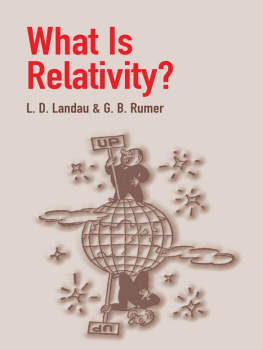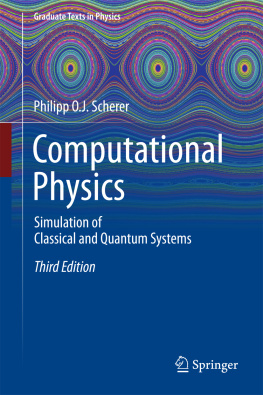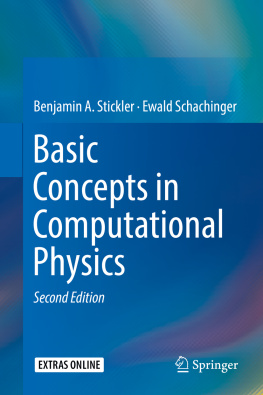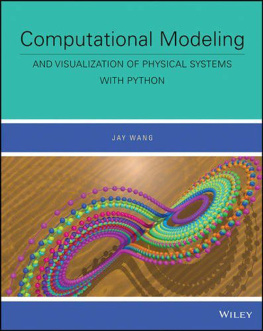Landau Rubin H. - Computational Physics
Here you can read online Landau Rubin H. - Computational Physics full text of the book (entire story) in english for free. Download pdf and epub, get meaning, cover and reviews about this ebook. year: 2015, publisher: John Wiley & Sons, Incorporated, genre: Home and family. Description of the work, (preface) as well as reviews are available. Best literature library LitArk.com created for fans of good reading and offers a wide selection of genres:
Romance novel
Science fiction
Adventure
Detective
Science
History
Home and family
Prose
Art
Politics
Computer
Non-fiction
Religion
Business
Children
Humor
Choose a favorite category and find really read worthwhile books. Enjoy immersion in the world of imagination, feel the emotions of the characters or learn something new for yourself, make an fascinating discovery.

- Book:Computational Physics
- Author:
- Publisher:John Wiley & Sons, Incorporated
- Genre:
- Year:2015
- Rating:3 / 5
- Favourites:Add to favourites
- Your mark:
- 60
- 1
- 2
- 3
- 4
- 5
Computational Physics: summary, description and annotation
We offer to read an annotation, description, summary or preface (depends on what the author of the book "Computational Physics" wrote himself). If you haven't found the necessary information about the book — write in the comments, we will try to find it.
Computational Physics — read online for free the complete book (whole text) full work
Below is the text of the book, divided by pages. System saving the place of the last page read, allows you to conveniently read the book "Computational Physics" online for free, without having to search again every time where you left off. Put a bookmark, and you can go to the page where you finished reading at any time.
Font size:
Interval:
Bookmark:
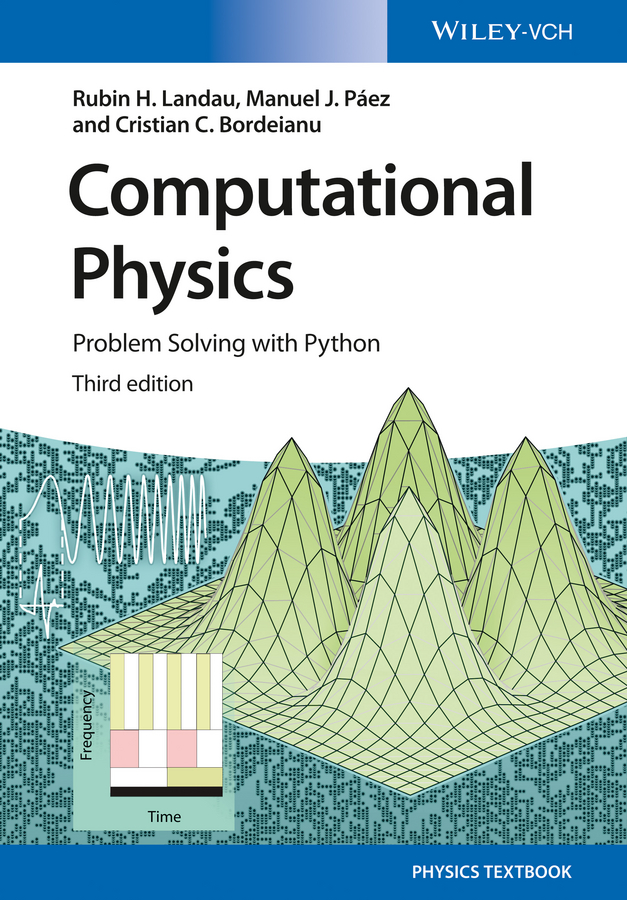
Paar, H.H.
An Introduction to Advanced Quantum Physics
2010
Print ISBN: 978-0-470-68675-1; also available in electronic formats
Har, J.J., Tamma, K.K.
Advances in Computational Dynamics of Particles, Materials and Structures
2012
Print ISBN: 978-0-470-74980-7; also available in electronic formats ISBN: 978-1-119-96589-3
Cohen-Tannoudji, C., Diu, B., Laloe, F.
Quantum Mechanics
2 Volume Set
1977
Print ISBN: 978-0-471-56952-7; also available in electronic formats
Schattke, W., Dez Muio, R.
Quantum Monte-Carlo Programming
for Atoms, Molecules, Clusters, and Solids
2013
Print ISBN: 978-3-527-40851-1; also available in electronic formats
Zelevinsky, V.
Quantum Physics 1&2
2 Volume Set
2011
Print ISBN: 978-3-527-41057-6; also available in electronic formats
3rd completely revised edition
Rubin H. Landau
Manuel J. Pez
Cristian C. Bordeianu

Rubin H. Landau
Oregon State University
97331 Corvallis OR
United States
Manuel J. Pez
Universad de Antioquia
Departamento Fisica
Medellin
Colombia
Cristian C. Bordeianu
National Military College tefan cal Mare
Campulung Moldovenesc
Romania
All books published by Wiley-VCH are carefully produced. Nevertheless, authors, editors, and publisher do not warrant the information contained in these books, including this book, to be free of errors. Readers are advised to keep in mind that statements, data, illustrations, procedural details or other items may inadvertently be inaccurate.
Library of Congress Card No.:
applied for
British Library Cataloguing-in-Publication Data:
A catalogue record for this book is available from the British Library.
Bibliographic information published by the Deutsche Nationalbibliothek
The Deutsche Nationalbibliothek lists this publication in the Deutsche Nationalbibliografie; detailed bibliographic data are available on the Internet at http://dnb.d-nb.de.
2015 WILEY-VCH Verlag GmbH & Co. KGaA,
Boschstr. 12, 69469 Weinheim, Germany
All rights reserved (including those of translation into other languages). No part of this book may be reproduced in any form by photoprinting, microfilm, or any other means nor transmitted or translated into a machine language without written permission from the publishers. Registered names, trademarks, etc. used in this book, even when not specifically marked as such, are not to be considered unprotected by law.
Print ISBN 978-3-527-41315-7
ePDF ISBN 978-3-527-68466-3
ePub ISBN 978-3-527-68469-4
Mobi ISBN 978-3-527-68467-0
To the memory of Jon Maestri
- 1 Introduction
- 2 Computing Software Basics
- 3 Errors and Uncertainties in Computations
- 4 Monte Carlo: Randomness, Walks, and Decays
- 5 Differentiation and Integration
- 6 Matrix Computing
- 7 Trial-and-Error Searching and Data Fitting
- 8 Solving Differential Equations: Nonlinear Oscillations
- 9 ODE Applications: Eigenvalues, Scattering, and Projectiles
- 10 High-Performance Hardware and Parallel Computers
- 11 Applied HPC: Optimization, Tuning, and GPU Programming
- 12 Fourier Analysis: Signals and Filters
- 13 Wavelet and Principal Components Analyses: Nonstationary Signals and Data Compression
- 14 Nonlinear Population Dynamics
- 15 Continuous Nonlinear Dynamics
- 16 Fractals and Statistical Growth Models
- 17 Thermodynamic Simulations and Feynman Path Integrals
- 18 Molecular Dynamics Simulations
- 19 PDE Review and Electrostatics via Finite Differences and Electrostatics via Finite Differences
- 20 Heat Flow via Time Stepping
- 21 Wave Equations I: Strings and Membranes
- 22 Wave Equations II: Quantum Packets and Electromagnetic
- 23 Electrostatics via Finite Elements
- 24 Shocks Waves and Solitons
- 25 Fluid Dynamics
- 26 Integral Equations of Quantum Mechanics
- 1 Introduction
- 2 Computing Software Basics
- 3 Errors and Uncertainties in Computations
- 4 Monte Carlo: Randomness, Walks, and Decays
- 5 Differentiation and Integration
- 6 Matrix Computing
- 7 Trial-and-Error Searching and Data Fitting
- 8 Solving Differential Equations: Nonlinear Oscillations
- 10 High-Performance Hardware and Parallel Computers
- 12 Fourier Analysis: Signals and Filters
- 13 Wavelet and Principal Components Analyses: Nonstationary Signals and Data Compression
- 18 Molecular Dynamics Simulations
- 19 PDE Review and Electrostatics via Finite Differences and Electrostatics via Finite Differences
- Appendix A: Codes, Applets, and Animations
Seventeen years have past since Wiley first published Landau and Pezs Computational Physics and twelve years since Cristian Bordeianu joined the collaboration for the second edition. This third edition adheres to the original philosophy that the best way to learn computational physics (CP) is by working on a wide range of projects using the text and the computer as partners. Most projects are still constructed using a computational, scientific problem-solving paradigm:

Our guiding hypothesis remains that CP is a computational science, which means that to understand CP you need to understand some physics, some applied mathematics, and some computer science. What is different in this edition is the choice of Python for sample codes and an increase in the number of topics covered. We now have a survey of CP which is more than enough for a full-years course.
The use of Python is more than just a change of language, it is taking advantage of the Python ecosystem of base language plus multiple, specialized libraries to provide all computational needs. In addition, we find Python to be the easiest and most accessible language for beginners, while still being excellent for the type of interactive and exploratory computations now popular in scientific research. Furthermore, Python supplemented by the Visual package (VPython) has gained traction in lower division physics teaching, and this may serve as an excellent segue to a Python-based CP course. Nevertheless, the important aspects of computational modeling and thinking transcends any particular computer language, and so having a Python alternative to our previous use of Fortran, C and Java may help promote this view (codes in all languages are available).
As before, we advocate for the use of a compiled or interpreted programming language when learning CP, in contrast to a higher level problem-solving environment like Mathematica or Maple, which we use in daily work. This follows from our experiences that if you want to understand how to compute scientifically, then you must look inside a programs black box and get your hands dirty. Otherwise, the algorithms, logic, and the validity of solutions cannot be ascertained, and that is not a good physics. Not surprisingly, we believe all physicists should know how to read programs how to write them as well.
Next pageFont size:
Interval:
Bookmark:
Similar books «Computational Physics»
Look at similar books to Computational Physics. We have selected literature similar in name and meaning in the hope of providing readers with more options to find new, interesting, not yet read works.
Discussion, reviews of the book Computational Physics and just readers' own opinions. Leave your comments, write what you think about the work, its meaning or the main characters. Specify what exactly you liked and what you didn't like, and why you think so.







